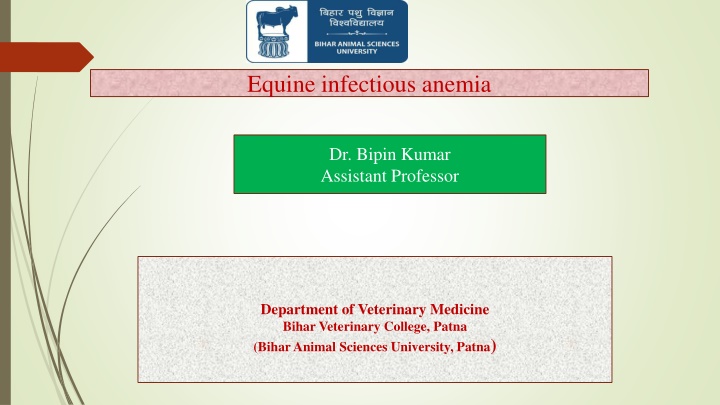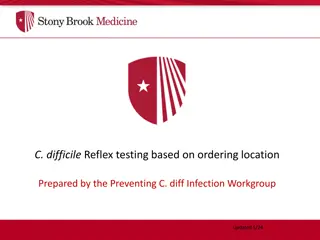
Equine Infectious Anemia: Causes, Transmission, and Symptoms
Learn about Equine Infectious Anemia, also known as Swamp Fever, including its etiology, symptoms, transmission methods, and clinical implications. Explore the impact of EIA on horses, donkeys, and mules, as well as post-mortem findings and potential differential diagnoses.
Download Presentation

Please find below an Image/Link to download the presentation.
The content on the website is provided AS IS for your information and personal use only. It may not be sold, licensed, or shared on other websites without obtaining consent from the author. If you encounter any issues during the download, it is possible that the publisher has removed the file from their server.
You are allowed to download the files provided on this website for personal or commercial use, subject to the condition that they are used lawfully. All files are the property of their respective owners.
The content on the website is provided AS IS for your information and personal use only. It may not be sold, licensed, or shared on other websites without obtaining consent from the author.
E N D
Presentation Transcript
Equine infectious anemia Dr. Bipin Kumar Assistant Professor Department of Veterinary Medicine Bihar Veterinary College, Patna (Bihar Animal Sciences University, Patna)
Synonyms Swamp Fever, Mountain Fever, Slow Fever, Equine Malarial Fever, Coggins Disease EIA first detected in U.S in 1888 EIA testing Coggins test Percent positive has decreased dramatically
Etiology/Epidemiology Equine infectious anemia virus, Family Retroviridae, Subfamily Orthoretrovirinae Genus Lentivirus Found nearly worldwide but May be absent from Iceland, Japan,U.S. Morbidity and Mortality Infection rate varies Geographic region (humid, swampy) Seroprevalence Up to 70 on endemic farms Affected by Virus strain and dose, Health of the animal
Mechanical transmission Mouthparts of biting insects Horse flies, stable flies, deer flies Fly behavior enhances transmission Bites painful Horses react Fly feeding interrupted Fly resumes feeding on same animal or nearby host Infectious blood transferred to new host
Fomites,Needles,Surgical instruments In utero,Via milk,Venereal,Aerosol etc All members of Equidae affected Clinical disease occurs in horses and ponies Donkeys may be asymptomatic
Horses Clinical signs often nonspecific Fever, weakness, depression Jaundice, tachypnea, tachycardia,Ventral pitting edema Petechiae, epistaxis , Anemia (chronically infected animals) Most recover and become carriers Infections may become symptomatic again during times of stress Donkeys and Mules Less likely to develop clinical signs,Can be infected (experimentally) with horse-adapted strains May develop clinical signs if infected with a donkey-adapted strain
Post Mortem Lesions Enlarged spleen, liver, lymph nodes, Pale mucous membranes,Emaciation,Edema Petechiae,Usually no lesions in chronic carriers. Differential Diagnosis Equine viral arteritis,Purpura hemorrhagica Leptospirosis,Babesiosis,Severe strongyliasis or fascioliasis Phenothiazine toxicity Autoimmune hemolytic anemia Other causes of fever/edema/anemia
Laboratory Diagnosis Serology Agar gel immunodiffusion/Coggins test Horses may be seronegative for first 2-3 weeks post-infection ELISA Can detect antibodies earlier More false positive occur Must be confirmed with AGID or immunoblot
RT-PCR Good for foals with maternal antibodies (up to 6-8 months of age) Used to confirm serological tests
Prevention and Control IMMEDIATELY notify authorities Most require testing Before entry of horses into the state Before participation in organized activities Before sale of horse Voluntary testing can help maintain an EIA-free herd No vaccine available
Lifelong carriers Must be permanently isolated or euthanized Reactors must be marked, Transport limited Vector control Spray Insect repellent Insect-proofing stables Separate herds of susceptible animals Clean and disinfect






















